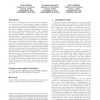267 search results - page 29 / 54 » On the approximability of influence in social networks |
HUC
2011
Springer
12 years 8 months ago
2011
Springer
As ubiquitous computing becomes increasingly mobile and social, personal information sharing will likely increase in frequency, the variety of friends to share with, and range of ...
WWW
2011
ACM
13 years 3 months ago
2011
ACM
In this work, we study the notion of competing campaigns in a social network. By modeling the spread of influence in the presence of competing campaigns, we provide necessary too...
JAIR
2008
13 years 8 months ago
2008
It is well-known that acting in an individually rational manner, according to the principles of classical game theory, may lead to sub-optimal solutions in a class of problems nam...
SIGECOM
2009
ACM
14 years 3 months ago
2009
ACM
The Target Set Selection problem proposed by Kempe, Kleinberg, and Tardos, gives a nice clean combinatorial formulation for many problems arising in economy, sociology, and medicin...
KESAMSTA
2009
Springer
14 years 1 months ago
2009
Springer
ent Artificial Immune Systems (MAAIS) for Intrusion Detection: Abstraction from Danger Theory Chung-Ming Ou, C.R. Ou Ants-like Agents: a Model and Analysis Based on Natural Ants Be...

